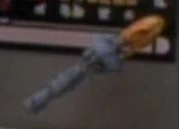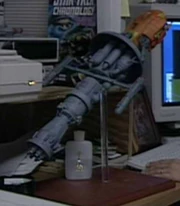(written from a Production point of view)

The Bonaventure display model
The Bonaventure (C1-21) has been one of the more elusive elements in Star Trek lore. Slated to become a significant part of Star Trek history as "Zefram Cochrane's first warp-powered spacecraft" from 2061, it nevertheless failed to do so in canon ultimately, though not for want of serious efforts on the part of production staffers to achieve such.
Design and reference model[]

|

|
The first (black and white) appearance of the Bonaventure was in the first, April 1993 edition of the reference book Star Trek Chronology (1st ed., pp. 18 & 20) as "Zefram Cochrane's first warp-powered spacecraft" from 2061, the reference model for which studio model vendor Greg Jein volunteered to design and build, and later to appear in several episodes of Star Trek: Deep Space Nine as graphic representations and as a display model in the role of set dressing. [1](X) On the model as featured in the book, only the registry "C1-21" was visible. The model was photographed by Chronology co-author and Scenic Art Department Supervisor Mike Okuda himself and photo-shopped by Scenic Artist Doug Drexler for representation in the book, the depiction on the cover being a painting.
The model had been one of five Jein had constructed for Okuda free of charge. "Greg Jein designed the version of Cochrane's ship that was featured in the Star Trek Chronology," Okuda clarified to Ex Astris Scientia (EAS), "He did the models as a favor to us, so we pretty much gave him free reign to make what he thought was appropriate. I told him that we thought the ship would be experimental and very powerful, so he came up with that big curved radiation shield. The only change we made was to add the two rudimentary warp nacelles. We wanted it to look like something from the Matt Jefferies universe, but we wanted it to look much more primitive, and far more dangerous." [2] The original reference model is still in the possession of Okuda, albeit without the warp nacelles, they having been ported over to the SS Valiant reference model as per Drexler, "Yes, the nacelles from the Bonaventure were used on the Valiant." [3](X)
Getting a name[]

Appearing as the Bonaventure
The name of the ship only appeared on the Deep Space Nine "Starship Chronology" wall display with the caption "Discovery of the Space Warp", a graphic backlit transparency created at Okuda's art department by Drexler, "Doug Drexler loved that model and later did a quick drawing of it for use in a number of background DS9 graphics, including the one you [EAS] mentioned," Okuda recalled, "I'm pretty sure that those graphics were the only time that we called it 'Bonaventure,' although we did suggest that name for use in Star Trek: First Contact. 'Phoenix' did end up being more appropriate, given the film's story." When asked about it by EAS, Drexler stated,
"Wow! I forgot about that one. That's a pretty early one for DS-9. Good times! Like so many of the graphics on the show, this one benefited by creation of the Star Trek Encyclopedia [sic.] by Mike and Denise. It was a resource to them, because I'd developed so many peripheral diagrams. If a backlit came out of the blue for an episode, I could put something fun together in no time flat. Sometimes you only had a few hours to get a last minute request addressed. The Bonaventure model that Greg Jein built for Mike as made specifically for the Star Trek Chronology. See that? I automatically called it 'The Bonaventure.' The idea is that it was built by Cochrane using off the shelf garage technology. At the time that seemed far fetched... from another era... like the Wright Brothers. Could never happen again. But then Burt Rutan [who built the experimental airplane Voyager to fly around the world] came along. I'm a believer! The Phoenix grew out of this design. Early in the planning of 'First Contact,' Mike and I had done a number of illustrations showing how it would get into orbit. By the way, 'Bonaventure' was absolutely a nod to the animated show."
The transparency itself hung for years on a wall in the art department, before ultimately ending up in the possession of British collector Adrian Hancock. [4] After Hancock's death in April of 2013, though, his heirs decided to resell the transparency as part of their gradual liquidation of "The Adrian Hancock Collection", the family's science fiction memorabilia holdings, (Live Auction of Film & Television Artifacts, 16 October 2014 auction catalog, p. 186) offering it up as Lot 659 at the 1 October 2019 "Entertainment Memorabilia Auction" of Prop Store of London, estimated at UK £1,000-1,500, and where it sold for UK£1,500 (without buyer's premium) [5]
Production copies[]

|

|

| |
The display model as featured in the two Deep Space Nine episodes, "In the Hands of the Prophets" and "Cardassians", was actually a copy of the original reference model, as Okuda additionally disclosed, "Greg later made a second copy of the model, which we provided to DS9 set decorator Laura Richarz for use as set dressing. The [angle of the] nacelles may have been slightly different in that version, which could account for the difference in the 'dihedral'. I think the flat version was the second model," which indeed it was as evidenced in the photograph as featured on the right. [6]
Jein's copy, when not in use as set dressing, resided initially on the desk of Mike Okuda in his office at the art department (DS9 Season 2 DVD-special feature, "Hidden File 01: Mike Okuda"), and later in front of the bulletin board of the department, suspended on wires from the ceiling. [7] Aside from its appearances as display model in the two Deep Space Nine episodes (only the wall chart was featured in "The Nagus"), the model has made one last appearance as such in Star Trek: Voyager's fifth season episode "Juggernaut", this time posing as a model of an old Malon ship, the Malon Pelk had built for the son of his colleague Fesek. In the episode Pelk even paid indirect homage to the quality of Jein's work when stating, "Hey, what do you think? Look at the detail on the dorsal plating," though strong green light flooding obscured the original colors of the model for its appearance in the episode. Ultimately, the display model met with a dismal fate, as Drexler later clarified, "The warp ship was dropped, and the cabin shattered. I have the pieces, and hopefully I will have some time to put it back together." [8](X)
Mike Okuda has confirmed that Jein had constructed an additional copy of the model for display in the "The History of the Future Museum" exhibition at the Las Vegas Star Trek: The Experience attraction. [9](X) After The Experience went defunct in 2008, that model ended up in the possession of noted Star Trek memorabilia collector Adam Schneider, who acquired the model in Propworx' "STAR TREK: THE EXPERIENCE Warehouse Sale" auction of 10 April 2010. [10](X) [11](X)
Legacy[]
In return of the favor Jein had provided, both Okuda and Drexler had tried hard during their tenure on the Star Trek franchise to get Jein's five designs elevated into canon, and while they succeeded for the Daedalus-class, DY-100-class (with the booster rockets) and, to some extent, Bonaventure models, they did not manage the same for the SS Valiant and a pre-Star Trek: The Original Series-era Romulan warbird. [12] Following the introduction of the Phoenix in First Contact however, Jein's model and all depictions of the Bonaventure were removed from the Deep Space Nine set and from the second edition of Star Trek Chronology. Okuda stated in that edition – without mentioning the name – that the Bonaventure was a conjectural design for what became the Phoenix. Several significant changes were made to the design, in part because the film required the ship to be launched from a missile.
Nevertheless, that Jein's design was not elevated to canon as Cochrane's first warp ship, was not for a want of trying, as Phoenix designer John Eaves divulged, "So when I started drawing it, I tried to keep in mind what Mike and Greg had designed for the Chronology. Doug Drexler meantime, had done some computer designs based on Greg's rocket – how it would fit into a rocket body, how it would lift, separate, and break apart into a warp ship. The Chronology's Phoenix simply didn't fit inside a Titan missile. So the design had to be based on a long body that would fit inside the Titan, with nacelles that folded out of the ship's center." Even with these changes in mind, any residual notion of Jein's design was eventually nixed by Production Designer Herman Zimmerman when presented by a modified design, deeming it "overdesigned, rather than a collection of salvaged parts patched together onto a ship", and the design was abandoned definitively with Eaves "back to the drawing board". (Star Trek: The Next Generation Sketchbook: The Movies, pp. 156-157)
Mike Okuda acknowledged this state of affairs in the second edition of his Chronology, released the same month First Contact premiered in November 1996; not only did he replace the C1-21 with an image of the Phoenix and retconned the year from 2061 to 2063, but he also added the above mentioned background annotation, "Cochrane's ship, the Phoenix, was designed by illustrator John Eaves under the direction of production designer Herman Zimmerman. Eaves's design was based on a conjectural design for Cochrane's ship developed by modelmaker Greg Jein for the first edition of this Chronology. (Eaves made several significant changes to the design of the Phoenix, in part because the storyline for Star Trek: First Contact reveals that Cochrane's ship was launched from an uprated U.S. Air Force Titan missile, a fact unknown to Jein at the time the first Chronology was compiled.)" (p. 28)
